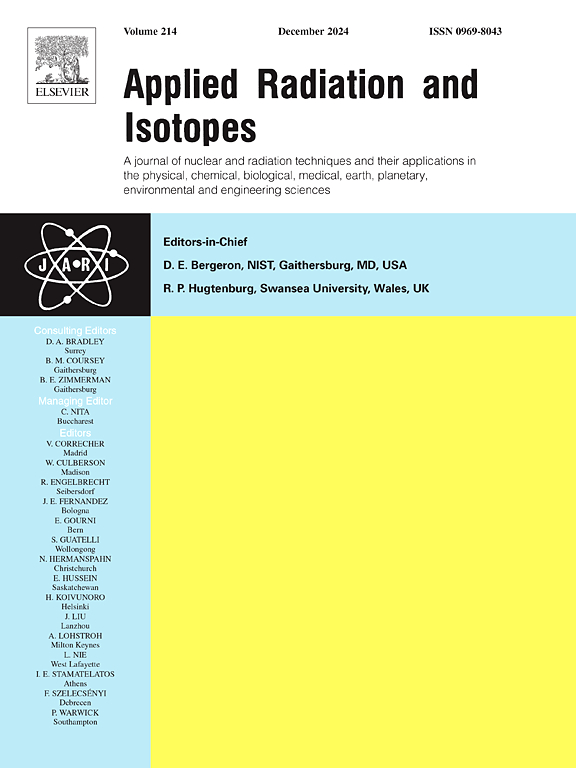铀污染地下水原位微生物修复的潜在风险:铀的释放和迁移
IF 1.6
3区 工程技术
Q3 CHEMISTRY, INORGANIC & NUCLEAR
引用次数: 0
摘要
在对受铀污染的地下水进行原位微生物修复后,由于微生物衰变导致固定在含水层中的铀重新迁移而引发的环境问题需要引起重视。在本研究中,铀吸附的 Leifsonia sp.自然腐烂产生了含铀的 Leifsonia sp.腐败菌。在不同的 pH 值、作用时间和金属离子 K+、Ca2+、Na+、Mg2+ 和 Zn2+ 浓度条件下,批量实验研究了雷夫索尼藻腐败物中铀释放的影响。通过 Leifsonia sp.腐败沙柱实验模拟了固定铀的再迁移。与没有金属离子时相比,在金属离子的作用下铀的释放率增加了 10%,其中 Ca2+ 的作用最大,达到 18.4%。此外,腐败物质中的铀(IV)被氧化成铀(VI),导致铀的释放,而铀的释放与腐败物质中的羟基、羧基、氨基和酰胺基团有关。铀的释放动力学与埃洛维奇模型和双常数模型一致,表明铀的释放是一个多因素综合化学解吸过程。此外,地下水中重吸收的铀由两部分组成:一部分铀从腐败物质中释放出来,以铀酰离子的形式独立迁移;另一部分铀存在于腐败物质中,随腐败物质迁移,前者的量远远大于后者。这项研究为合理利用微生物原位沥滤铀来修复受铀污染的地下水提供了理论依据。本文章由计算机程序翻译,如有差异,请以英文原文为准。
Potential risks of in-situ microbial remediation of uranium-contaminated groundwater: Uranium release and remigration
After in-situ microbial remediation of uranium-contaminated groundwater, the environmental problems caused by the remigration of uranium immobilized in the aquifer due to microbial decay require attention. In this study, uranium-containing Leifsonia sp. spoilage was produced by natural decay of uranium-adsorbed Leifsonia sp.. Batch experiments were used to investigate the influence on uranium release from the Leifsonia sp. spoilage under the conditions of different pH, action time, and concentrations of the metal ions K+, Ca2+, Na+, Mg2+, and Zn2+. The remigration of immobilized uranium was simulated by the Leifsonia sp. spoilage sand column experiment. The release rate of uranium initially decreased with increasing pH, increased with increasing contact time, and then remained unchanged with increasing time; the release rate of uranium peaked at 4.98 % at pH 3 and 120 h. Compared to the absence of metal ions, the release rate of uranium increased by >10 % under the action of metal ions, in which Ca2+had the greatest effect, up to 18.4 %. Furthermore, U(IV) in the spoilage was oxidized to U(VI), resulting in uranium release, and uranium release was related to hydroxyl, carboxyl, amino, and amide groups in the spoilage. The release kinetics of uranium were consistent with those of the Elovich and double constant models, indicating that the release of uranium was a multifactorial integrated chemical desorption process. In addition, the remigrated uranium in groundwater had two components: some of the uranium was released from the spoilage and migrated independently as uranyl ions, and some was present in the spoilage and migrated with the spoilage, the amount of the former being much greater than that of the latter. This study provides a theoretical basis for the rational use of microbial in-situ remediation of uranium-contaminated groundwater by in-situ leaching of uranium.
求助全文
通过发布文献求助,成功后即可免费获取论文全文。
去求助
来源期刊

Applied Radiation and Isotopes
工程技术-核科学技术
CiteScore
3.00
自引率
12.50%
发文量
406
审稿时长
13.5 months
期刊介绍:
Applied Radiation and Isotopes provides a high quality medium for the publication of substantial, original and scientific and technological papers on the development and peaceful application of nuclear, radiation and radionuclide techniques in chemistry, physics, biochemistry, biology, medicine, security, engineering and in the earth, planetary and environmental sciences, all including dosimetry. Nuclear techniques are defined in the broadest sense and both experimental and theoretical papers are welcome. They include the development and use of α- and β-particles, X-rays and γ-rays, neutrons and other nuclear particles and radiations from all sources, including radionuclides, synchrotron sources, cyclotrons and reactors and from the natural environment.
The journal aims to publish papers with significance to an international audience, containing substantial novelty and scientific impact. The Editors reserve the rights to reject, with or without external review, papers that do not meet these criteria.
Papers dealing with radiation processing, i.e., where radiation is used to bring about a biological, chemical or physical change in a material, should be directed to our sister journal Radiation Physics and Chemistry.
 求助内容:
求助内容: 应助结果提醒方式:
应助结果提醒方式:


